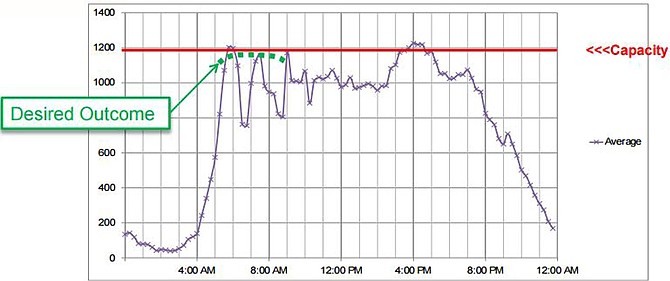Plans to extend rush hour times to four hours hope to spread traffic out further. Photo by Vernon Miles.
Arlington County hasn’t quite decided what to do about I-66. While the final vote for endorsing the Virginia Department of Transportation’s (VDOT) plans doesn’t take place until Thursday, Nov. 19, discussion of the topic consumed over three hours of the public hearing on Nov. 14.
While the plans have come under fire regionally for the planned implementation of tolls for single passenger vehicles on I-66, the major concern in Arlington seems to be the potential widening of the road.
According to Amanda Baxter, special projects development manager for VDOT, the possible widening would add an eastbound lane from the Dulles connector road to Fairfax Drive in Ballston. The goal is to reduce congestion and get less cars on the road, but with the additional of single passenger cars and the delay in the High Occupancy Lane requirement increase, some on the County Board believed it may do the exact opposite.
“I’m unsure about the tenability of this plan,” said County Board member Libby Garvey. “What I’m not understanding is how this is going to move more people and fewer vehicles. People who are on the road can stay on the road, and we’re going to have more single occupancy vehicles. It’s the same number of people and vehicles.”
Baxter responded that extending the hours where the limitations are in effect and introducing the “managed lanes” concept with tolls based on congestion will spread out the time period for drivers heading to work. But Garvey countered that the rush hour times are what they are today because of the hours people arrive at work, which doesn’t change with the toll.
Baxter also argued that the new tolls contribute revenue which will be reinvested in other transportation options. The highlights of this, according to Baxter, are an increased carpool accessibility and new funding for buses.
“There will be five park and rides outside beltway,” said Baxter. “Three exist and two are brand new. The three are enhanced with direct access into hot-lane facility. Now I have the choice to look for a person to ride with and travel reliably. That is an incentive we don’t have today. We have people coming out [to meetings] to say they want to be HOV but they don’t have places to park and they don’t know how to get picked up. We’re providing those places, but we also want to put in strategies… to market how people do that more efficiently.”
Baxter also said bus improvements could be a major help for congestion.
“A bus could have 55 people instead of 55 cars,” said Baxter. “But unless we give them easier choices to make, we’re not going to see change.”
On this topic, Garvey was also still skeptical.
“It’s feeling a bit like the chicken and egg to me,” said Garvey. “I understand if there are these wonderful options, people will take them. But they’re not there now, and we’re about to put in place something that’s not going to produce them for maybe a long time and it’s not clear how it’s going to produce them and it’s not clear that there’s going to be enough revenue. So, I would prefer to have those choices available before this gets implemented so people have a way to change their behaviors.”
Baxter said that many of the improvements, like the hot lane accessibility and some of the bus improvements, are being implemented in spring of 2016, a year before tolling is put into place.
Despite concerns, the feedback from the community was mostly positive.
“The current proposal preserves the quality of life in our community and works to move people, not just vehicles, through the corridor,” said Adrienne Pilot, former transportation committee chair for the Arlington County Civic Federation. “Our orange line is not called orange crush for no reason. I urge you to support with the concerns and consideration that has been expressed by staff.”
But the support for the proposal was universally contingent on it not leading to the widening of I-66.
“With the exception of the widening, we support VDOT’s transform I-66 multimodal improvement project inside the beltway,” said David Dickson, volunteer transportation chair for the Mount Vernon Sierra Club. “We commend [the] approach that focuses on moving more people, reducing congestion, creating more opportunities for travel through the corridor, and improving the reliability of travel times for all travellers.”
County Board member Walter Tejada reemphasized that he would oppose any measure that involved widening I-66, but said that he’ll keep an open mind on the subject when it comes up to a vote later this week.
